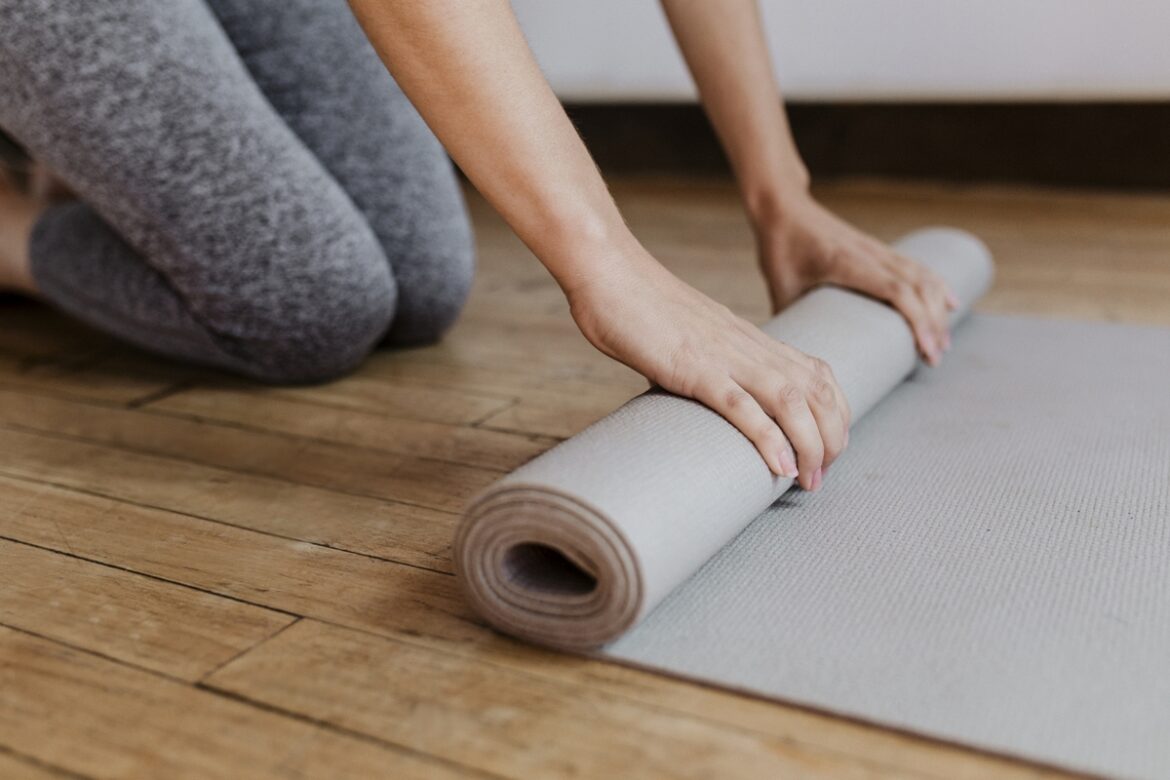
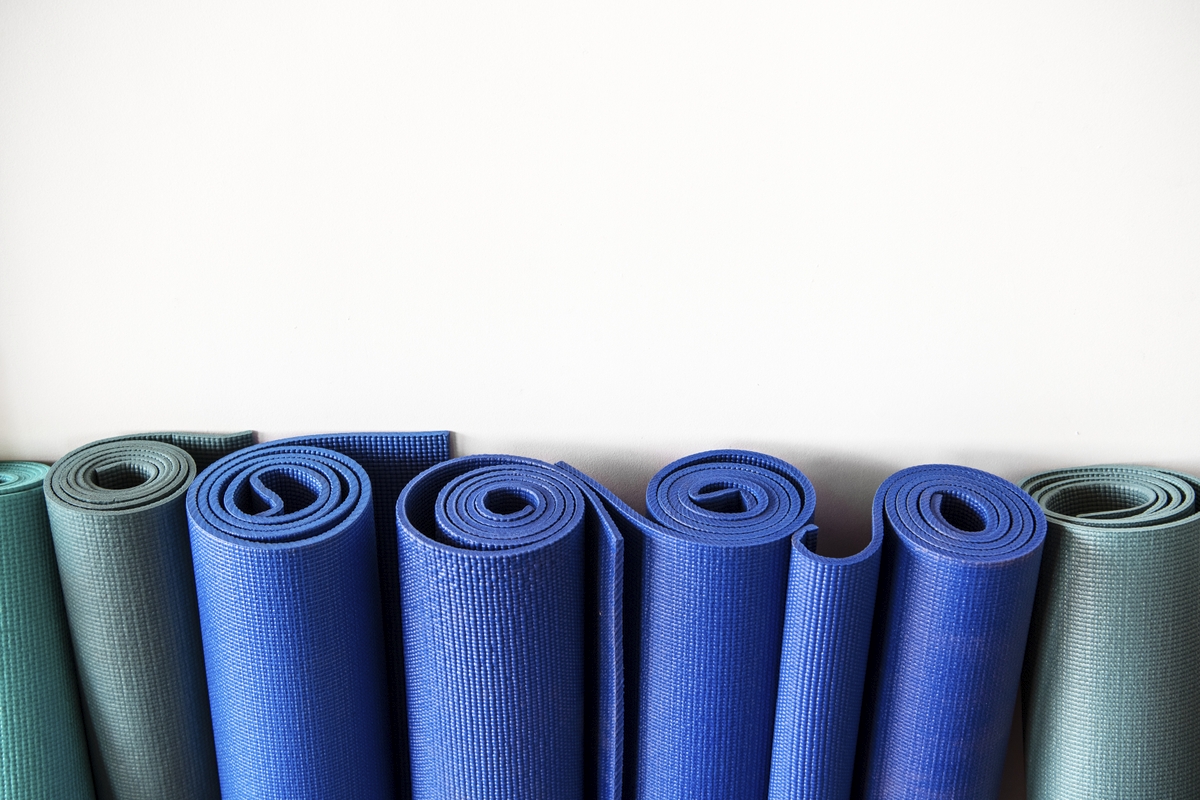

Rolls of yoga mats at a fitness center
The Ultimate Guide to Choosing the Right Workout Mat for Your Fitness Routine
When it comes to improving your fitness regimen, one often underestimated yet crucial aspect is the workout mat. Whether you are practicing yoga, Pilates, engaging in high intensity interval training (HIIT) or doing floor exercises, investing in the workout mat can significantly enhance your performance and overall experience. In this guide, we will explore the significance of using a workout mat. How it affects your fitness routines effectiveness.
Importance of Using a Workout Mat
A workout mat acts as a foundational support for your exercise routine by providing stability and comfort. It serves as a barrier between your body and the floor safeguarding your joints, bones and muscles from strain and impact. Moreover, workout mats offer a slip surface that ensures safety during movements, while preventing injuries. By utilizing a workout mat you create a space dedicated to your exercises physically and mentally which can boost motivation and concentration.
How a Workout Mat Impacts Fitness Routine Performance
The numerous performance benefits of using a workout mat.
There are performance benefits associated with using a workout mat. First a workout mat serves as a cushion reducing the strain, on your body when you are doing exercises involving jumping, kneeling, or lying down. This helps you maintain form and technique while minimizing the risk of discomfort or injury.
Additionally, a workout mat provides traction and grip which is beneficial for maintaining balance and stability during poses or movements that require shifting your weight.
Lastly using a workout mat creates a space for your fitness routine. Psychologically it signals the start of your workout. Enhances your concentration and focus.
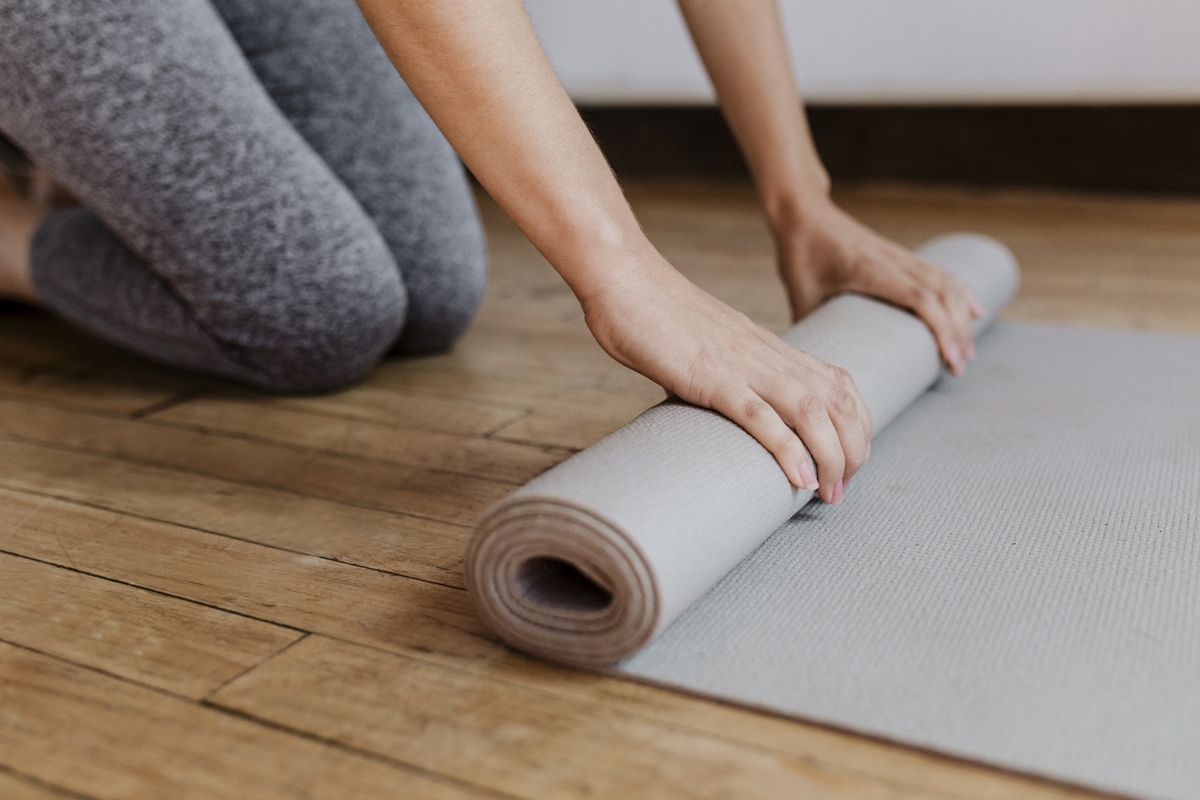
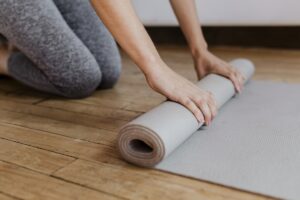
Sporty woman rolling a yoga mat
Types of Workout Mats
Now let us explore the types of workout mats to cater to specific exercise needs.
Yoga Mats
Yoga mats are designed to accommodate the dynamic nature of yoga poses. These mats are typically thin to thick providing cushioning for joints while ensuring stability. Yoga mats are made with materials that offer grip enabling you to hold poses without slipping. The textured surface ensures traction during sweaty workouts. Furthermore, yoga mats are lightweight and easily portable making them convenient, for both studio classes and home practices.
Benefits of Using Yoga Mats
- Improved stability and balance during yoga poses
- Cushioned support for joints and bones
- Enhanced grip and traction for better pose holds.
- Lightweight and portable for ease of transportation
Pilates Mats
Pilates mats are designed to provide adequate comfort and support for the various Pilates exercises that emphasize core strength, flexibility, and controlled movements. These mats are often thicker than yoga mats, offering more cushioning for the spine and joints. Pilates mats are made from high-density foam or rubber, which absorb impact and provide a stable surface for Pilates workouts. Additionally, these mats are larger in size to accommodate full-body movements typically involved in Pilates routines.
Benefits of Using Pilates Mats
- Increased comfort and support for spine and joints
- Absorption of impact for controlled movements
- Larger size for optimal movement range
- Durable and long-lasting for sustained use
Exercise Mats
Exercise mats cater to a wide range of fitness routines beyond yoga and Pilates. These mats are versatile in nature, suitable for cardio workouts, strength training, and bodyweight exercises. Exercise mats come in various thickness options to cater to different intensity levels and preferences. Most exercise mats are made of durable materials such as PVC, rubber, or foam, offering ample cushioning and stability for diverse workout styles.
Benefits of Using Exercise Mats
- Versatile for a variety of fitness routines
- Customizable thickness options for different intensity levels
- Ample cushioning and stability for dynamic movements
- Durability for long-lasting use
Additional Types of Workout Mats
Apart from yoga mats, Pilates mats, and exercise mats, there are lesser-known types of workout mats that cater to specific needs. These alternative mats include:
- Acupressure mats: Designed with plastic spikes, these mats stimulate pressure points for therapeutic benefits and pain relief.
- Balance mats: These mats have an uneven surface, challenging your balance and stability during exercises, improving core strength.
- Anti-fatigue mats: Ideal for standing exercises, these mats offer exceptional cushioning to reduce strain and fatigue on the feet and lower body.
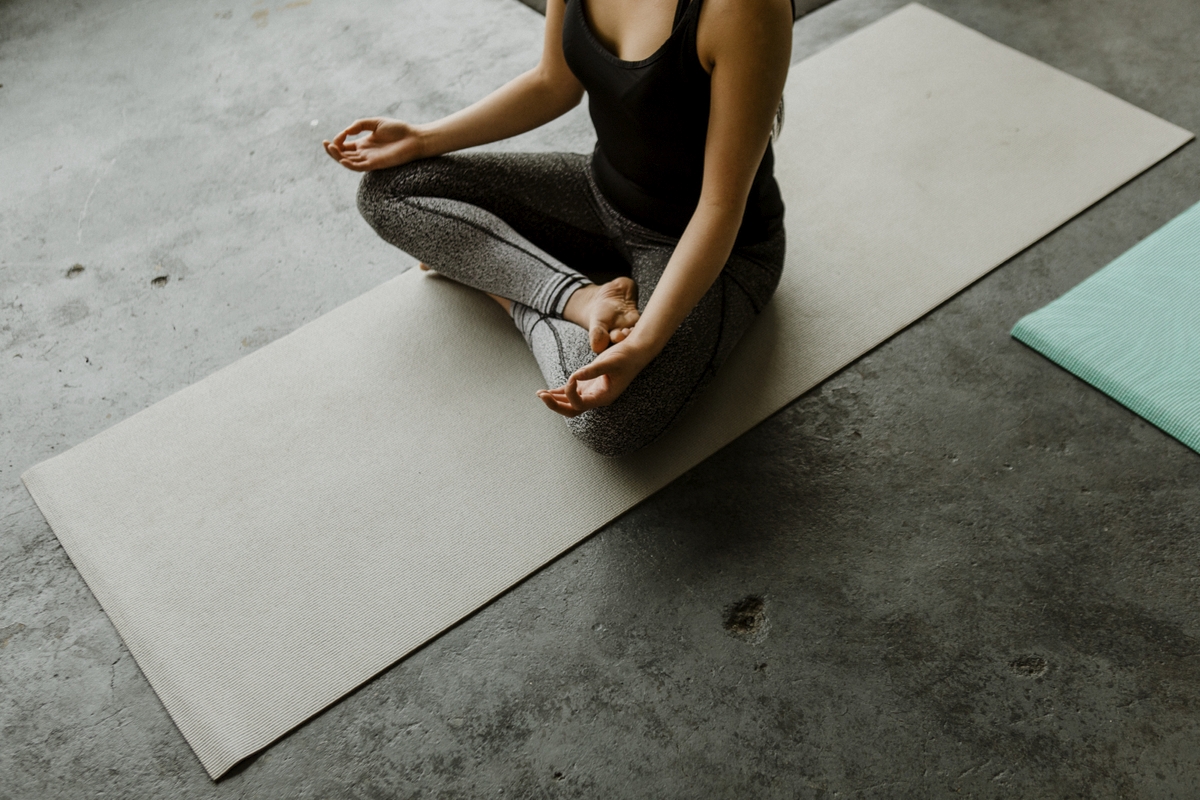
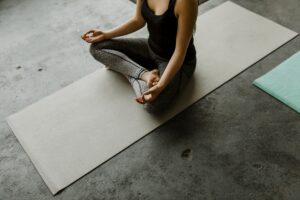
Woman meditating in a yoga class
Factors to Consider When Choosing a Workout Mat
To ensure you select the right workout mat for your fitness routine, it is important to consider the following factors:
Thickness
The thickness of a workout mat determines the level of cushioning and support it provides. Thicker mats are suitable for high-impact exercises, while thinner mats are preferred for balance and stability-focused routines.
Material
Dissimilar materials offer varying levels of comfort, durability, and grip. Common mat materials include PVC, rubber, foam, and natural fibres like cork or jute.
Pros and Cons of Different Mat Materials
- PVC: Affordable, durable, and easy to clean but may not be eco-friendly.
- Rubber: Provides excellent grip and cushioning, but individuals may be sensitive to the smell.
- Foam: Lightweight, affordable, and offers good cushioning, but may not be as durable as other materials.
- Natural fibres: Environmentally friendly and biodegradable but may lack the same level of grip and durability as synthetic materials.
Durability
Consider the mat’s durability, ensuring it withstands prolonged use and frequent movements without showing signs of wear and tear. Look for mats with reinforced edges or anti-tear technology.
Size and Dimensions
Choose a mat that provides sufficient space to fully accommodate your body during exercises. Consider both length and width to ensure optimal comfort and movement range.
Portability
If you often travel or attend fitness classes, opt for a mat that is lightweight and easily foldable or comes with a carrying strap for convenient transportation.
Comfort and Cushioning
Assess the level of cushioning required for your specific workouts. Some routines may benefit from extra cushioning, especially for joints and sensitive areas, while others may require a firmer surface for stability.
Grip and Traction
Ensure the mat offers a non-slip and grippy surface to prevent accidental slips and maintain stability during various movements.
Understanding the Different Fitness Routines and Their Mat Requirements
Different fitness routines have unique mat requirements based on the nature of the exercises performed. Let us explore the specific considerations for yoga, Pilates, HIIT, and floor exercises.
Yoga
Yoga poses and their impact on mat selection.
- Dynamic poses: Look for a mat with optimal grip and cushioning to support transitions and fluid movements.
- Balance poses: Choose a mat that provides a stable surface with good traction to prevent slips and falls.
- Restorative poses: opt for a mat with extra cushioning for enhanced comfort during longer holds.
Pilates
Pilates exercises and their impact on mat selection
- Mat exercises: Consider a thicker mat to provide adequate cushioning for rolling movements and core exercises.
- Full-body movements: Select a larger mat to accommodate leg extensions, arm reaches, and other wide range movements.
- Stability work: Look for a mat with a grippy surface to ensure stability during balance-centric exercises.
High-Intensity Interval Training (HIIT)
Fitness routines requiring high impact mats.
- Jumping exercises: Choose a mat with excellent shock absorption and stability to protect joints during intense jumps and landings.
- Plyometric exercises: opt for a mat that offers sufficient thickness and cushioning to minimize the risk of injury.
Floor Exercises
Mat requirements for various floor exercises
- Bodyweight exercises: A mat with moderate cushioning and grip is recommended to provide comfort and stability throughout the workout.
- Core exercises: Consider a mat that offers support for the spine and joints to maintain proper alignment during core-focused routines.
How to Choose the Right Mat for Your Fitness Routine
To make an informed decision, consider the following step-by-step guide:
Step-by-Step Guide
- Assess your workout needs: Determine the type of exercises you primarily engage in, and the level of impact involved.
- Consider your fitness goals: Identify your objectives, such as improving flexibility, building strength, or enhancing stability, and choose a mat that aligns with those goals.
- Evaluate your budget: Set a reasonable budget range and explore mats within that range. Remember to prioritize quality, durability, and functionality over price alone.
- Try before you buy: Whenever possible, test out different mats in a store or borrow from a friend to get a feel for the thickness, grip, and overall comfort. Consider online reviews to gather more insights.
Importance of Personal Preference
It is worth mentioning that personal preference plays a role. Find a mat that you genuinely enjoy using as this can boost your motivation and enhance your workout experience. Consider factors, like color, design and texture that resonate with you and make your fitness routine more enjoyable.
Conclusion
To maximize the effectiveness and safety of your fitness routine choosing the right workout mat is crucial. By understanding the types available, considering factors mentioned above and evaluating your specific exercise requirements you will be able to select a mat perfectly aligned with your fitness goals.
It is essential to keep in mind that choosing the workout mat is crucial. Not does it provide the support, for your body during exercises but it also contributes to a more enjoyable fitness journey. Make sure to highlight how selecting the right workout mat plays a role, in achieving performance while preventing any avoidable injuries.
